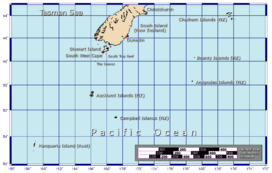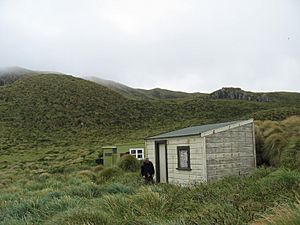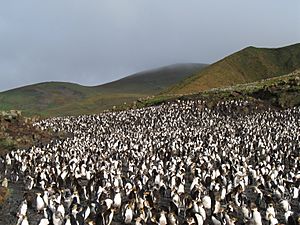Antipodes Subantarctic Islands tundra facts for kids
Quick facts for kids Antipodes Subantarctic Islands tundra |
|
|---|---|

Bluffs on Macquarie Island
|
|

The position of the Antipodes Subantarctic Islands relative to New Zealand
|
|
| Ecology | |
| Realm | Australasian |
| Biome | tundra |
| Geography | |
| Area | 817 km2 (315 sq mi) |
| Countries | Australia and New Zealand |
| Conservation | |
| Conservation status | Relatively stable/intact |
| Protected | 116 km² (14%) |
The Antipodes Subantarctic Islands tundra is a special natural area. It includes five faraway island groups in the Pacific Ocean. These islands are south of New Zealand. They are the Bounty Islands, Auckland Islands, Antipodes Islands, and Campbell Island groups from New Zealand. The fifth island is Macquarie Island, which belongs to Australia. This whole area is a type of tundra environment.
Contents
What are these islands like?

These islands have been alone for a very long time. They are far from other land and even far from each other. This isolation, along with tough weather, has created unique life. The weather is cold, with strong winds from the west. There isn't much sunlight in winter.
Because of this, many plants and animals here are endemic. This means they are found nowhere else in the world. However, there aren't many different types of species overall. Winds often blow at about 40 kilometers per hour (25 mph). Even in summer, thick clouds block much of the sun.
The Bounty Islands are small, rocky islands made of granite. Their highest point is 88 meters (289 feet). The Antipodes Islands are also small, reaching 366 meters (1,201 feet). The largest group is the Auckland Islands, which are 705 meters (2,313 feet) high. Campbell Island is 569 meters (1,867 feet) high. These three groups are all volcanic in origin.
Macquarie Island is the furthest south and the coldest. Its highest point is 433 meters (1,421 feet). The soil on these islands is mostly wet, boggy peat. It can be up to 8 meters (26 feet) deep in flat areas. No one lives permanently on these islands. But scientists do visit for research. Australia has a research base on Macquarie Island.
Plants of the Islands
The plants on these islands are quite special. In sheltered spots on the Aucklands and parts of Campbell Island, you might see small forests of Southern rātā. Other areas have tussock grasslands, shrublands, and cushion plants.
These islands are a meeting point for plants. They have species from the very cold Antarctic south and from warmer temperate climates to the north. Many plants are endemic, meaning they grow only here. For example, a type of Cyathea tree fern grows here. It's the southernmost tree fern in the world.
Macquarie Island is colder, with an average temperature of 5°C (41°F). It doesn't have any trees or large woody plants. The tiny Bounty Islands have almost no soil. Their plants are mostly algae and lichens growing on the rocks. Some rare plants live here, like the unique Auckland Island Pleurophyllum. Also, the only subantarctic orchids, Corybas dienemus and Corybas sulcatus, are found on Macquarie Island.
Animals of the Islands
You won't find any native land mammals, amphibians, or reptiles on these islands. But the marine life is amazing! Five types of seals breed here. These include the southern elephant seal, Australasian fur seal, subantarctic fur seal, Antarctic fur seal, and the rare New Zealand sea lion. About 95% of the world's New Zealand sea lions breed on the Auckland Islands.
The islands are also home to huge numbers of penguins and other seabirds. Almost half of the world's albatross species breed here! This includes the only breeding colonies of the Antipodean albatross, southern royal albatross, Campbell albatross, white-capped albatross, and Salvin's albatross. On the Bounty Islands, Salvin's albatrosses build nests from feathers because there are no plants to use.

Some land birds have also settled here. They were likely blown off course by strong ocean winds. Many of these have become unique species over time. For example, there are two endemic parakeets on Antipodes Island: the Antipodes parakeet and Reischek's parakeet. Many insects, like butterflies and moths (called Lepidoptera), have also evolved into unique species found only here.
Sadly, some species have disappeared since people discovered the islands. These include the Macquarie Island rail and the Macquarie Island parakeet.
Protecting the Islands
Even though people have visited these islands at different times, most of their natural habitats are still in good condition. However, there are some threats. Animals brought by humans, like rats and cats, hunt the native wildlife. They also eat the plants. Both mammals and seabirds can get caught in deep-sea fishing equipment. Fishing for tuna and squid is especially harmful.
Efforts are being made to remove the introduced animals. For example, all cats have been removed from Macquarie Island. This has already helped some seabird populations grow. All of these islands are now nature reserves and World Heritage Sites. This means they are protected globally. (The Bounty Islands are not a Centre of Plant Diversity, but the others are).
If you want to visit the New Zealand islands, you need permission from the Department of Conservation (New Zealand). For Macquarie Island, you need permission from the Tasmania Parks and Wildlife Service.
See Also
- Subantarctic Islands of New Zealand

